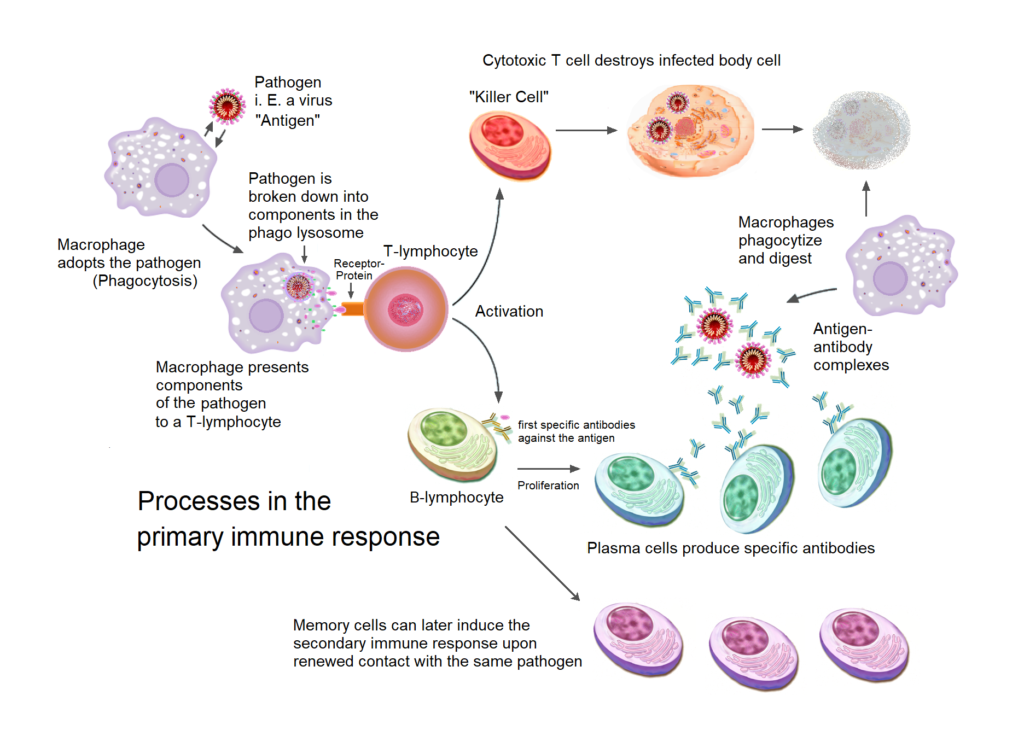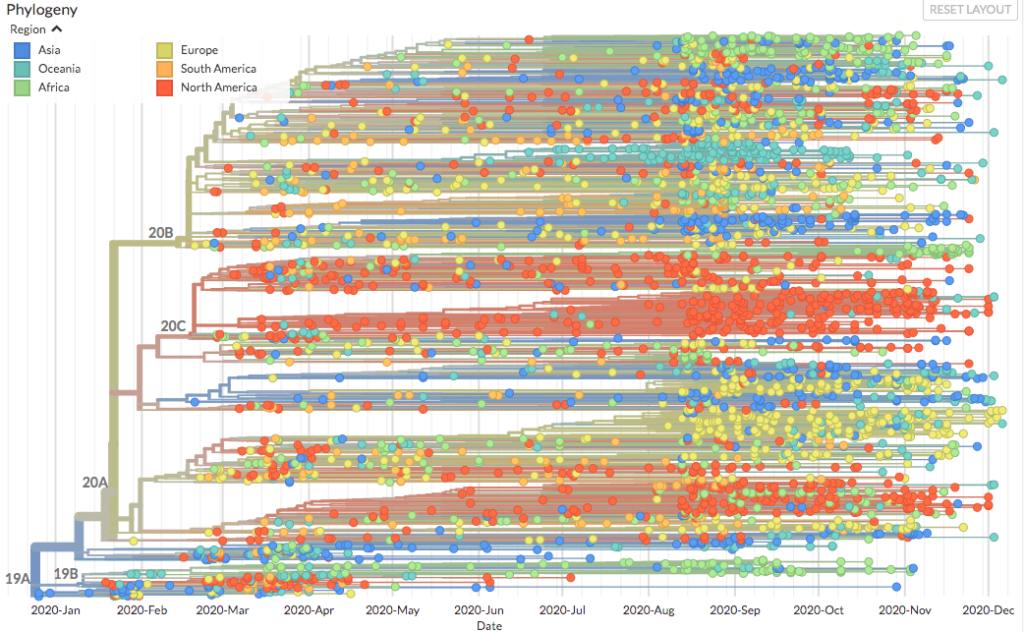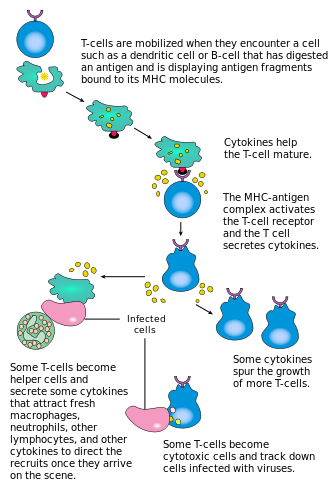Basics
Basics about humans, immunity & virus infections
Strangely our media, government officials and mainstream experts omit any mention of the power of the human immune system.
For millions of years our human body has an amazingly fine-tuned protective mechanism called the immune system. It is designed to defend you against millions of bacteria, microbes, viruses, fungi, toxins and parasites that would love to invade your body every second. But obviously our immune system is doing something amazing to keep invaders of all sorts like bacteria, microbes, viruses, and parasites from dismantling our bodies. Without this very well functioning immun system the human race would not exist.
Our immune system is made up of different organs, cells, and proteins that work together and has two main parts:
– The natural or innate immune system, which you are born with.
The innate immune system is the oldest component of the human immune system and our rapid response system. It is inherited and is active from the moment we are born. When this system recognizes an invader, it goes into action immediately and the invader is killed inside our immune system cells. Evolution has shaped human immune systems thanks to genetic adaptation of human populations, which explains why there are significant differences, today, between the immune systems of Africans and Europeans. So our bodies immune response is determined by our genes. Your innate immunity is a fast immune response that provides the first line of immunological defense in a non-specific matter against infections.
– The adaptive, specific or acquired immune system when your body is exposed to microbes or chemicals released by microbes. It develops during your life and provides slow but specific immunity. The adaptive immune system is like an immunity database able to create immunological memory against antigens. After encountering a specific pathogen, your body has immune cells that can recall the best way to destroy it.
There are many diseases that, if you catch them once, you will never catch them again, because your body is able to recall how to eliminate it immediately before it can do anything to you.
Your immune system is already a very powerful machine to fight all kind of diseases, but can be impacted by our environment, diet, sleep, stress, travel, and other lifestyle factors. You also can actively make sure that your immune system functions excellently.
A healthy immune function is a whole-body effort and maintaining it takes a holistic approach.
Steps you can take to keep or acquire a healthy immune system:
– Get at least seven hours of sleep at night
– Exercise regularly and get a lot of sunshine and fresh air outdoors
– Minimize stress as much as possible or practice healthy coping strategies
– Eat a healthy, balanced diet full of organic vegetables, fruits, lean proteins to provide essential micro- and macronutrients and important phytonutrients.
– Practice good hygiene, including frequent hand washing
We all are exposed to millions of microorganisms every day and will be for the rest of our lives. Scientists have determined that there are approximately 30 trillion cells, 40 trillion bacteria and 380 trillion viruses on and in the average size human body. The viruses that have evolved with us for so many years are not only part of our past, but will play a significant role in the future of human health. There are thousands of species of bacteria and viruses that compete for space and control of our tissues, made up of beneficial players, opportunists and harmful actors. We call these healthy organisms symbiotic, because we both benefit from each other. Actually, we could not survive without them!
These organisms are significantly influenced by how we live, sleep, exercise, what we eat and drink and our lifestyles determine whether we assist our symbiotic organisms to give them the upper hand and help to provide us with resistance to disease, or we sabotage their efforts and promote the growth of destructive organisms and the demise of our health. These lifestyle factors even effect how our genes are expressed.
It is estimated that there are approximately 200 species of respiratory viruses; influenza viruses, rhinoviruses, coronaviruses, adenoviruses, parainfluenza viruses, respiratory syncytial virus and more.
The human body has always lived and interacted with these viruses and thousands more. Many of these categories of viruses can cause severe illness and even death in certain people. In other people those infections are very mild and self-limiting. In fact, it’s exposure to these viruses, bacteria, and fungi that matures and strengthens our immune systems. So, the notion that we should avoid all germs is preposterous and actually damaging to our health. It is no surprise and not unique to this version of coronavirus or any other pathogenic virus or bacteria that people with comorbidities, diseases, autoimmune diseases, poorly nourished with low nutrient dense food are at much greater risk of severe complications and death.
Every year there is a mix of flu viruses: first the rhinoviruses, then the influenza A and B viruses, followed by the coronaviruses. This year was nothing different from any other season.
For some diseases, like measles, mumps, polio, typhoid etc. vaccines have been developed. But the common cold or influenza can not be cured by vaccines, because they mutate quickly and have so many different strains that it is impossible to have a vaccine for the exact newly mutated strain. So each time you get e.g. the flu you are getting a different strain of the same disease.
The coronavirus, SARS-CoV-2, is no exception and not unique. Infectious diseases have ravaged the same groups with mortality levels being much higher in densely populated areas. The different comorbidities have a lowered immune resistance providing a good host for the SARS-CoV-2. It is an RNA virus, which is more prone to changes and mutations compared with DNA viruses like smallpox. So, as it has been passing from person to person over the past months, it has been, and continues to be, mutating.
RNA viruses are characterized by a high mutation rate, up to a million times higher than that of their hosts. The virus is evolving and European, North American and Asian strains might coexist, each of them characterized by a different mutation pattern.
Over many years there have been six coronavirus serotypes associated with disease in humans: HCoV-229E, HCoV-NL63, HCoV-OC43, HCoV-HKU1, SARS-CoV, SARS-CoV-2, and MERS-CoV. Since our bodies had to deal with different coronaviruses in the past, it appears that most people already have a congenital or general immunity to e.g. influenza and other viruses.
A study in the journal Cell shows that most people neutralize the coronavirus by mucosal and cellular immunity (T-cells), while experiencing few or no symptoms. A study detected SARS-CoV-2-reactive CD4+ T cells in ∼40%–60% of unexposed individuals, suggesting cross-reactive T cell recognition between circulating “common cold” coronaviruses and SARS-CoV-2.
Most people therefore already have a congenital or cross-immunity because they were already in contact with variants of the same virus.
That is probably the cause why most people who test positive (PCR) have no complaints. Their immune system is strong enough. So strengthening natural immunity is a very logical and healthy approach.
Therefore prevention is an important, insufficiently highlighted pillar: healthy, full-fledged nutrition, exercise in fresh air, without a mask, stress reduction and nourishing emotional and social contacts.
We urgently need your support !!
There are many easy ways how to do this. Please find the information here:
>How to Support Us <
>Shop at our Affiliate Partner Shops<
Find books, nutritions, vitamins, groceries, outdoor products, travel deals, and many more on our pages:
Dietary Supplements, Immune Support
or please Donate here 🙂
To understand the power of our immune system please find more information here:
Overview of Immunity
https://courses.lumenlearning.com/boundless-microbiology/chapter/overview-of-immunity/
How Your Immune System Works
https://health.howstuffworks.com/human-body/systems/immune/immune-system.htm
Answers to Common Questions About How Viruses Work
https://askthescientists.com/common-virus-questions/
The Immune System: Your Body’s Guards
https://askthescientists.com/immune-system/
Difference Between Innate and Adaptive Immunity
https://www.differencebetween.com/difference-between-innate-and-vs-adaptive-immunity/
Invaders in our DNA: Ancient Viruses Help Fight Today’s Infections
https://healthcare.utah.edu/the-scope/shows.php?shows=0_qgxjvuag
Regulatory evolution of innate immunity through co-option of endogenous retroviruses
https://science.sciencemag.org/content/sci/351/6277/1083.full.pdf
Evidence for Evolution in Human Immune Systems
https://evmedreview.com/evidence-for-evolution-in-human-immune-systems/
Virus Genes in Human DNA May, Surprisingly, Help Us Fight Infections
https://www.smithsonianmag.com/science-nature/virus-genes-human-dna-may-surprisingly-help-us-fight-infections-180958276/
Why Has Everyone Seemingly Forgotten How the Immune System Works?
https://childrenshealthdefense.org/news/why-has-everyone-seemingly-forgotten-how-the-immune-system-works/
To understand viruses please find information here:
Virus Genes in Human DNA May, Surprisingly, Help Us Fight Infections
https://www.smithsonianmag.com/science-nature/virus-genes-human-dna-may-surprisingly-help-us-fight-infections-180958276/
Human Virome: Scientists say 380 Trillion viruses live inside of us
https://www.inverse.com/article/49747-what-is-the-human-virome
To understand the corona viruses please find more information here.
Coronaviruses
https://www.uptodate.com/contents/coronaviruses?sectionName=VIROLOGY&topicRef=126981&anchor=H2&source=see_link
Genomic epidemiology of novel coronavirus – Global subsampling
https://nextstrain.org/ncov/global
SARS-CoV-2 mutation
https://pubmed.ncbi.nlm.nih.gov/32321524/
Targets of T Cell Responses to SARS-CoV-2 Coronavirus in Humans with COVID-19 Disease and Unexposed Individuals
https://www.cell.com/cell/fulltext/S0092-8674(20)30610-3
All information is deemed accurate but not guaranteed and should be independently verified.





